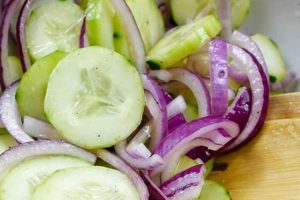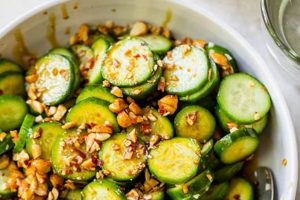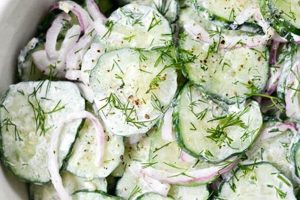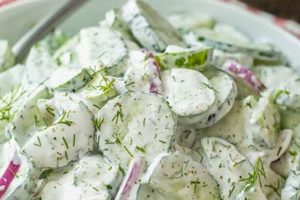A guide to preparing a cucumber salad in the Japanese style typically involves a specific set of ingredients and techniques. These often include thinly sliced cucumbers, a vinegar-based dressing, and seasonings such as sesame seeds, soy sauce, and sometimes chili flakes or ginger. Variations exist, incorporating ingredients like wakame seaweed or different types of vinegar, leading to a range of flavor profiles from sweet and sour to savory and spicy.
This dish offers a refreshing and light addition to a meal, often served as a side dish or part of a bento box. Its simple preparation makes it accessible to home cooks of all skill levels, while its adaptable nature allows for creativity and personalization. Historically, such salads reflect Japanese culinary principles emphasizing fresh, seasonal ingredients and balanced flavors. The methods used, like quick pickling or marinating, also contribute to preserving vegetables and enhancing their taste.
The following sections will delve into specific variations of this culinary creation, covering detailed instructions, ingredient lists, and tips for achieving optimal results. Further exploration will also touch upon the cultural significance of this dish within Japanese cuisine and its increasing popularity globally.
Tips for Japanese Cucumber Salad
Optimizing the preparation of Japanese cucumber salad involves attention to detail and a few key techniques. These tips ensure a refreshing, flavorful, and texturally pleasing final product.
Tip 1: Salt and Drain Cucumbers: Salting the thinly sliced cucumbers and allowing them to drain for approximately 15 minutes draws out excess moisture. This crucial step prevents a watery salad and allows the dressing to adhere more effectively.
Tip 2: Thinly and Evenly Slice Cucumbers: Consistent, thin slices ensure even marination and contribute to a pleasant texture. A mandoline slicer is ideal, but a sharp knife used carefully yields excellent results.
Tip 3: Balance Sweet, Sour, and Salty Flavors: The hallmark of a successful dressing lies in the balance of rice vinegar’s sweetness, soy sauce’s saltiness, and optional additions like sugar or mirin for extra sweetness. Taste and adjust as needed.
Tip 4: Toast Sesame Seeds: Toasting sesame seeds enhances their nutty aroma and adds a deeper layer of flavor to the salad. Toast lightly in a dry pan until fragrant.
Tip 5: Chill Before Serving: Chilling the salad for at least 30 minutes allows the flavors to meld and intensifies the refreshing quality of the dish.
Tip 6: Explore Ingredient Variations: While traditional recipes offer a solid foundation, experimentation with ingredients such as different types of vinegar, the addition of seaweed, chili flakes, or ginger can create unique and exciting flavor profiles.
Tip 7: Don’t Overdress: Adding the dressing just before serving prevents the cucumbers from becoming soggy. Start with a small amount and add more as needed.
By following these guidelines, one can elevate a simple cucumber salad into a delightful culinary experience, showcasing the nuances of Japanese flavors and techniques.
The following section will conclude with a summary of key takeaways and suggestions for incorporating this versatile dish into various meal settings.
1. Thinly Sliced Cucumbers
Thinly sliced cucumbers form the foundation of a Japanese cucumber salad, impacting both texture and flavor absorption. The thinness of the slices is crucial for achieving the desired balance of crispness and marinade penetration. This section explores the multiple facets of this seemingly simple yet essential element.
- Surface Area Maximization
Thin slicing maximizes the cucumber’s surface area, allowing the dressing to coat each piece thoroughly. This ensures optimal flavor infusion, creating a harmonious blend of cucumber and dressing in every bite. Increased surface area also promotes faster and more even marination, crucial for quick preparation.
- Texture Enhancement
Thinly sliced cucumbers offer a delicate, almost translucent quality, contributing to the salad’s refreshing lightness. The delicate texture contrasts pleasantly with other components, such as crunchy sesame seeds or seaweed, enhancing the overall sensory experience. This thinness also makes the cucumbers easier to eat with chopsticks.
- Visual Appeal
The thin, often overlapping slices create an aesthetically pleasing presentation. The translucence allows light to pass through, highlighting the vibrant green color and adding a touch of elegance to the dish. This visual appeal contributes to the overall dining experience, showcasing the care taken in preparation.
- Methodological Considerations
Achieving consistently thin slices requires a sharp knife or a mandoline slicer. The chosen method influences the final presentation and texture. A mandoline yields uniform slices, while a skilled hand with a knife can create subtle variations in thickness, adding textural interest. The slicing method also impacts preparation time and efficiency.
The precise slicing of cucumbers is integral to a successful Japanese cucumber salad. From flavor absorption to visual presentation, the thinness of the slices directly impacts the final dish’s overall quality and enjoyment. This seemingly simple step elevates the salad from a mere combination of ingredients to a carefully constructed culinary experience.
2. Rice Vinegar Dressing
Rice vinegar dressing stands as a defining element in Japanese cucumber salad, contributing significantly to its characteristic flavor profile. The dressing provides a delicate balance of sweetness, acidity, and umami, complementing the cucumber’s refreshing crispness. An understanding of its components and their interplay is crucial for appreciating its role in this culinary creation.
- Acidity and Sweetness Balance
Rice vinegar possesses a milder acidity compared to other vinegars, lending a gentle tang rather than a sharp sourness. This mild acidity balances the added sweetness, typically from sugar or mirin, creating a harmonious flavor profile that enhances the cucumber’s natural freshness. The specific ratio of vinegar to sweetener determines the final balance, allowing for adjustments based on individual preferences.
- Umami Depth from Soy Sauce and Other Seasonings
Soy sauce introduces umami, a savory depth, to the dressing, adding complexity to the overall flavor profile. Other seasonings, such as sesame oil, ginger, or chili flakes, can further enhance the umami notes and introduce additional layers of flavor complexity. The interplay of these savory elements with the sweet and acidic components creates a well-rounded and nuanced taste experience.
- Flavor Infusion and Cucumber Enhancement
The dressing’s relatively thin consistency allows it to penetrate the cucumber slices effectively, infusing them with flavor. This infusion process not only seasons the cucumbers but also subtly alters their texture, enhancing their delicate crispness. The balance of flavors in the dressing prevents it from overpowering the cucumber’s natural taste, instead complementing and elevating it.
- Versatility and Adaptability
While a basic rice vinegar dressing typically includes rice vinegar, sugar, and soy sauce, its inherent versatility allows for numerous variations. The addition of ingredients like mirin, sake, ginger, garlic, or sesame oil can create a broader spectrum of flavor profiles, from subtly sweet to savory and spicy. This adaptability allows for customization based on personal preferences and the specific context of the meal.
The rice vinegar dressing acts as more than just a condiment; it is an integral component of the Japanese cucumber salad experience. Its carefully balanced flavors enhance the cucumber’s natural qualities, resulting in a dish that is both refreshing and nuanced. The dressing’s adaptability further contributes to the dish’s versatility, making it a welcome addition to a variety of culinary settings.
3. Sesame Seeds
Sesame seeds constitute a frequent component of Japanese cucumber salad, contributing both flavor and texture. Their presence offers a nutty depth, complementing the refreshing cucumber and the tangy rice vinegar dressing. The seeds subtle crunch provides a textural counterpoint to the cucumber’s crispness, enhancing the overall sensory experience. Moreover, sesame seeds offer nutritional benefits, containing healthy fats, fiber, and minerals. Their inclusion aligns with broader culinary trends emphasizing the use of ingredients that provide both flavor and nutritional value. For instance, a traditional Japanese cucumber salad often features toasted white sesame seeds, their nutty aroma and subtle crunch adding a layer of complexity.
The method of incorporating sesame seeds can further influence the final dish’s character. Toasted sesame seeds provide a more pronounced, roasted flavor, while raw seeds offer a milder taste and softer texture. Black sesame seeds present a visually striking alternative, adding a touch of elegance to the salad’s presentation while offering a slightly different flavor profile. One might encounter variations where the seeds are ground into a paste, incorporated into the dressing itself, or sprinkled directly onto the salad just before serving. Each method results in a unique expression of the interplay between the sesame seeds and the other components.
Understanding the role of sesame seeds extends beyond simply including them in the recipe. It highlights the deliberate choices made in crafting a balanced and flavorful dish. Consideration of the type of sesame seeds, their preparation, and their integration method contributes to the overall success of the Japanese cucumber salad. This attention to detail distinguishes a thoughtfully prepared dish from a merely adequate one. The integration of sesame seeds, therefore, exemplifies the broader principle of mindful ingredient selection in Japanese cuisine, where each element serves a distinct yet harmonious purpose.
4. Soy Sauce Seasoning
Soy sauce seasoning plays a crucial role in Japanese cucumber salad, contributing significantly to the overall balance of flavors. Its presence provides a salty and umami-rich counterpoint to the refreshing cucumber and the tangy rice vinegar dressing, adding depth and complexity. An understanding of soy sauce’s multifaceted contribution is essential for appreciating its significance in this seemingly simple dish.
- Saltiness and Umami
Soy sauce introduces a foundational saltiness that balances the other flavors within the salad. This saltiness is not merely one-dimensional; it carries with it a rich umami depth derived from the fermentation process. This umami, often described as a savory, meaty flavor, adds a layer of complexity, preventing the salad from tasting overly simplistic. The specific type of soy sauce used can influence the intensity of both saltiness and umami, further impacting the final flavor profile.
- Flavor Enhancement and Balancing Agent
Beyond its inherent flavors, soy sauce acts as a flavor enhancer, amplifying the other ingredients’ tastes. It helps to harmonize the sweetness of the rice vinegar and the freshness of the cucumber, creating a unified flavor profile. Its presence prevents the salad from being overly sweet or bland, contributing to a well-rounded taste experience. The quantity of soy sauce used plays a crucial role in achieving this balance.
- Color and Visual Appeal
Soy sauce contributes to the visual appeal of the salad, adding a touch of rich brown color to the predominantly green and white components. This subtle color enhancement makes the dish more visually appealing, increasing its overall aesthetic value. The color contribution also subtly signals the presence of umami and saltiness, creating anticipation for a more complex flavor profile.
- Cultural Significance and Regional Variations
Soy sauce is a staple in Japanese cuisine, and its inclusion in cucumber salad reflects broader cultural preferences for savory and umami-rich dishes. Regional variations in soy sauce production further influence the final taste of the salad. For example, using a lighter, sweeter soy sauce results in a different flavor profile compared to a darker, more robust variety. These regional nuances add another layer of depth to this seemingly simple dish.
The integration of soy sauce in Japanese cucumber salad extends beyond mere seasoning. It represents a considered approach to flavor balancing, drawing upon traditional Japanese culinary principles. The interplay of saltiness, umami, and visual enhancement demonstrates the multifaceted role soy sauce plays in elevating this simple salad into a harmonious and flavorful dish. The choice of soy sauce variety and its quantity further reflect an understanding of how this key ingredient contributes to the overall culinary experience.
5. Optional Chili Flakes
Chili flakes, while not a traditional element, offer an increasingly popular customization option within Japanese cucumber salad recipes. Their judicious use introduces a layer of complexity, contrasting the refreshing coolness of the cucumber and the tangy dressing with a spicy kick. Understanding the role and impact of this optional ingredient provides insight into the evolving nature of culinary traditions and individual preferences.
- Heat and Flavor Complexity
Chili flakes introduce a piquant heat that interacts dynamically with the other flavor components. This heat can range from a subtle warmth to a fiery intensity depending on the type and quantity used. Beyond pure heat, chili flakes contribute a complex flavor profile, often described as earthy, smoky, or even slightly fruity, depending on the chili variety. This complexity adds depth and dimension to the otherwise straightforward flavor profile of the salad.
- Balancing Act and Flavor Contrast
The inclusion of chili flakes necessitates careful consideration of balance. The heat should complement, not overpower, the other flavors. The goal is to create a dynamic interplay between the spicy heat, the refreshing cucumber, and the tangy dressing. This contrast creates a more stimulating and engaging culinary experience, appealing to those seeking a bolder flavor profile.
- Visual Interest and Culinary Cues
The vibrant red color of chili flakes adds visual interest to the salad, creating a subtle yet noticeable contrast against the predominantly green and white palette. This visual cue also signals the presence of spice, preparing the palate for the anticipated heat. This interplay of visual and gustatory sensations enhances the overall dining experience.
- Cultural Adaptation and Individualization
The adoption of chili flakes into some Japanese cucumber salad recipes reflects a broader trend of culinary fusion and personalization. While not traditionally a part of Japanese cuisine, the incorporation of chili reflects evolving palates and a willingness to experiment with new flavor combinations. This adaptability highlights the dynamic nature of food culture and the individualization of recipes based on personal preferences.
The inclusion of chili flakes, while optional, demonstrates the potential for nuanced customization within the framework of a traditional dish. It allows individuals to tailor the flavor profile to their specific preferences, creating a more personalized and engaging culinary experience. The careful balancing of heat and flavor complexity exemplifies the broader principle of thoughtful ingredient selection, even within the realm of optional additions. This attention to detail ultimately elevates the Japanese cucumber salad from a simple side dish to a more dynamic and nuanced culinary creation.
6. Fresh Ginger (optional)
Fresh ginger, while an optional addition, offers a distinct dimension to Japanese cucumber salad. Its inclusion introduces a pungent, slightly sweet, and spicy flavor profile that complements the refreshing cucumber and the tangy rice vinegar dressing. The ginger’s aromatic compounds interact with the other ingredients, creating a more complex and nuanced sensory experience. This complexity arises from gingerols and shogaols, the bioactive compounds responsible for ginger’s distinctive flavor and aroma. For example, a small amount of finely grated fresh ginger added to the dressing can brighten the overall flavor profile without overpowering the delicate cucumber.
The use of fresh ginger also carries practical implications beyond flavor enhancement. Ginger is known for its digestive benefits, aiding in digestion and potentially reducing bloating. This functional aspect aligns with the broader emphasis on health and well-being within Japanese cuisine. Additionally, ginger’s anti-inflammatory properties offer potential health benefits. One might observe regional variations where ginger is more prevalent, reflecting local culinary traditions and preferences. In some instances, pickled ginger might be used, offering a different textural and flavor experience compared to fresh ginger. These variations highlight the adaptability of the recipe and the potential for personalized interpretations.
The decision to include fresh ginger underscores the potential for nuanced customization within a seemingly simple dish. Understanding the interplay of flavors and the potential health benefits allows for informed choices regarding ingredient selection and preparation methods. Balancing the intensity of fresh ginger with the other components ensures a harmonious final product. This careful consideration elevates the Japanese cucumber salad from a basic side dish to a more thoughtful and nuanced culinary creation, reflecting broader principles of flavor balance and ingredient synergy within Japanese culinary traditions.
Frequently Asked Questions
This section addresses common inquiries regarding Japanese cucumber salad preparation, offering concise and informative responses to clarify potential uncertainties.
Question 1: What type of cucumber is best suited for this salad?
While any cucumber variety can be used, Japanese cucumbers, Persian cucumbers, or English cucumbers are preferred due to their thin skin and less watery flesh. These varieties contribute to a crispier texture and minimize the risk of a watery salad.
Question 2: Can the dressing be made ahead of time?
The dressing components can be combined in advance and stored separately. However, it is recommended to dress the cucumbers just before serving to maintain their optimal crispness and prevent them from becoming soggy.
Question 3: How long can the salad be stored?
While best consumed fresh, the dressed salad can be stored in an airtight container in the refrigerator for up to two days. The texture may soften slightly over time.
Question 4: What are some alternatives to rice vinegar?
In the absence of rice vinegar, white wine vinegar or apple cider vinegar can be used as substitutes. However, these alternatives possess different flavor profiles and may subtly alter the overall taste of the salad.
Question 5: Can other vegetables be added?
While the focus remains on cucumbers, incorporating thinly sliced carrots, daikon radish, or wakame seaweed can add textural and flavor complexity.
Question 6: How can one adjust the level of spiciness?
The amount of chili flakes added directly correlates to the level of spiciness. Start with a small amount and adjust upwards based on individual preference. Fresh ginger can also contribute to the spicy notes.
Careful attention to these details ensures a successful outcome when preparing Japanese cucumber salad. Understanding the nuances of ingredient selection, preparation techniques, and flavor balancing contributes to a truly satisfying culinary experience.
The next section will offer concluding remarks and suggestions for further exploration of Japanese cuisine.
Conclusion
Exploration of the elements constituting a Japanese cucumber salad recipe reveals a deceptively simple dish rich in nuanced flavor and cultural significance. From the precise slicing of cucumbers to the delicate balance of rice vinegar, soy sauce, and optional additions like sesame seeds, chili flakes, and ginger, each component contributes to the final product’s harmonious character. Understanding the interplay of these ingredients allows for informed choices regarding ingredient selection, preparation techniques, and flavor customization, ultimately elevating the dish beyond a mere side item to a carefully crafted culinary experience.
The continued appreciation and adaptation of this dish within diverse culinary landscapes underscore its enduring appeal. Further exploration of regional variations and ingredient substitutions promises continued evolution and personalized interpretations, enriching the ongoing narrative of culinary exchange and innovation. The seemingly simple act of preparing a Japanese cucumber salad offers a gateway to a deeper appreciation of Japanese culinary principles, highlighting the transformative potential of fresh ingredients and balanced flavors.






